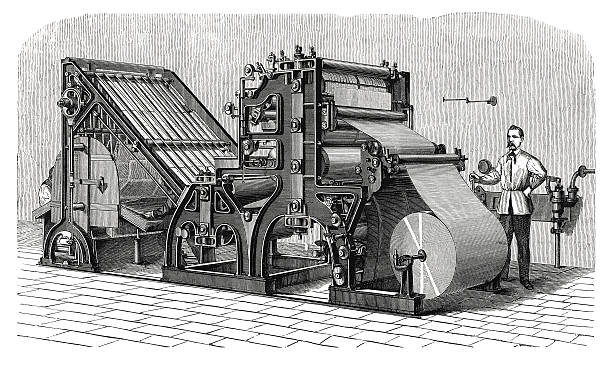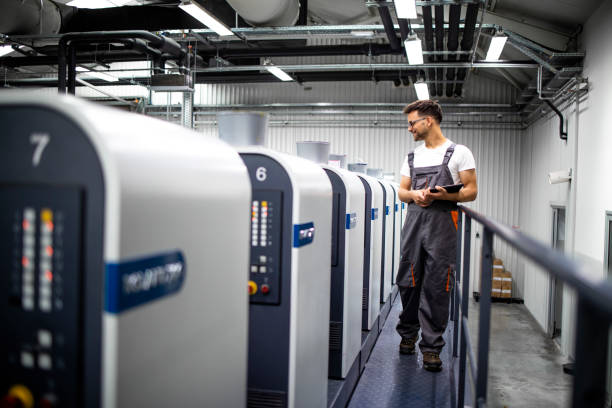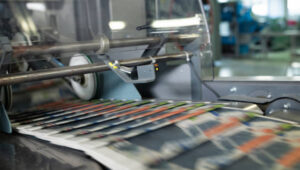The print trade industry in Australia has gone through a remarkable transformation over the years, moving from traditional methods to digital technology. This evolution has revolutionized the way printing services are produced and consumed. Australian Trade Printers, a leading company in the print trade industry, has been at the forefront of this shift, embracing digital solutions to provide high-quality signage, printing services, and more. In this article, we will delve into the historical journey of the print trade, exploring its key milestones and the technological advancements that have shaped the industry.

The Dawn of Print Trade: Ancient Techniques
The history of print trade dates back to ancient civilizations, where early printing techniques were developed. These ancient print techniques laid the foundation for the future advancements in the print trade industry.
The Inception of Cylinder Seals and Stamps
One of the earliest methods of printing was the use of cylinder seals and stamps. In Mesopotamia and China, cylinder seals and stamps were used to certify documents by making impressions on clay tablets and other surfaces. These seals and stamps were made from stone or metal and featured intricate designs that could be rolled or pressed onto the materials. This ancient print technique ensured the authenticity and integrity of important documents in ancient civilizations.
From Block Seals to Pottery: The Diversity of Early Printing
In addition to cylinder seals and stamps, early printing techniques also included the use of block seals. Characters or images were carved into blocks of wood or stone, which were then used to make impressions on various materials, including pottery. This process allowed for the creation of decorative patterns and designs on pottery objects, showcasing the artistic capabilities of early printers. The diversity of early printing techniques demonstrates the ingenuity and creativity of ancient civilizations in their approach to print trade.
Movable Type and the Printing Press: Pioneering Change
The invention of movable type and the printing press revolutionized the print trade industry. In China, Bi Sheng developed movable type made from clay, but this method had limited use compared to traditional printing techniques. However, in Europe, Johannes Gutenberg invented the printing press and mass-produced metal type, leading to the widespread circulation of printed materials. Gutenberg’s invention, along with movable type, enabled the economical production of books, newspapers, and other printed materials on a large scale. This marked a significant turning point in print trade history and paved the way for the dissemination of knowledge and the spread of literacy.
Bi Sheng’s Revolution: The Birth of Movable Type
In ancient China, Bi Sheng made a groundbreaking contribution to the print trade with the invention of movable type. Unlike previous methods that involved carving complete pages or blocks of text, Bi Sheng developed individual characters using clay. Each character could be arranged and rearranged to form words and sentences, giving printers more flexibility in producing different texts. Although this method showed promise, it didn’t gain widespread adoption due to the limitations of working with clay.
Johannes Gutenberg’s Legacy: The Printing Press
The printing press, invented by Johannes Gutenberg in the 15th century, became one of the most significant technological advancements in the print trade. Gutenberg’s innovation involved creating a press that used movable metal type instead of clay. This allowed for faster and more efficient printing, as well as the ability to reproduce large quantities of written material. The printing press revolutionized the spread of information and knowledge, making books and other printed materials more accessible to the masses. Gutenberg’s invention laid the foundation for the printing revolution that followed, shaping the course of the print trade for centuries to come.If there was a Print Trade Pty Ltd, it would be Gutenberg’s flagship.
| Movable Type | Printing Press |
|---|---|
| Invented by Bi Sheng | Invented by Johannes Gutenberg |
| Made from clay | Made from metal |
| Limited use compared to traditional printing techniques | Enabled the mass production of printed materials |
| Flexible arrangement of individual characters | Faster and more efficient printing |
| Did not gain widespread adoption | Revolutionized the spread of information and knowledge |
Print Trade in the Renaissance: Spreading Knowledge
The Renaissance period was a time of immense cultural and intellectual growth, and the print trade played a pivotal role in this era of enlightenment. With the invention of the printing press, knowledge became more accessible to a wider audience, leading to an unprecedented spread of ideas, scientific discoveries, and artistic creations.
In major European cities such as Venice and Florence, printing centers flourished, where skilled craftsmen worked tirelessly in printing workshops to produce a wide range of printed materials. These included religious texts, scientific treatises, literary works, and artwork. The print trade became a catalyst for intellectual and cultural advancement, shaping the Renaissance period.
The printing industry not only allowed for the reproduction of existing knowledge but also facilitated the creation of new works. Scholars, scientists, and artists could now share their ideas with a broader audience and engage in intellectual exchange. The dissemination of knowledge through printed books and publications fueled the Renaissance’s thirst for knowledge and sparked the appetite for learning.
The print trade in the Renaissance era not only influenced the intellectual landscape but also transformed society as a whole. Access to books and printed materials fostered literacy and education, enabling individuals to become more informed and enlightened. It empowered individuals to challenge conventional wisdom and explore new realms of thought.
The impact of the print trade during the Renaissance extended beyond Europe, influencing other parts of the world as well. The spread of printed materials facilitated cultural exchange and cross-cultural understanding, contributing to the growth of global knowledge.
The printing industry played a central role in spreading ideas, fostering intellectual exchange, and shaping the cultural and intellectual landscape of the Renaissance period. It was a time of immense creativity, innovation, and curiosity, and the print trade was at the forefront of this transformative era.
Innovation in the Industrial Era: New Techniques Emerge
The Industrial Revolution brought about significant innovations in the print trade industry. Technological advancements during this period paved the way for new techniques that revolutionized printing processes, accelerating the growth and expansion of the print trade.
Lithography to Chromolithography: Colour Hits the Press
One notable innovation during the industrial era was lithography, a printing technique that used flat stone or metal plates to transfer ink onto paper. This method allowed for the creation of detailed illustrations and multi-color prints, marking a significant milestone in the history of print trade. With lithography, the print industry could produce vibrant and visually appealing prints that captivated audiences and set the stage for future artistic and commercial advancements.
Building upon the foundation laid by lithography, the development of chromolithography further elevated the print trade. Chromolithography involved the printing of designs using multiple colors, enhancing the visual impact of printed materials. This breakthrough allowed for the creation of vivid and realistic images, making printed materials more visually engaging and appealing to consumers. From vibrant posters to decorative prints, chromolithography opened up new possibilities in the print trade, enabling the industry to satisfy the growing demand for aesthetically pleasing and eye-catching designs.
The Rotary Press: Accelerating the Print Trade
The introduction of the rotary press during the industrial era revolutionized the speed and efficiency of the printing process. The rotary press, a technological advancement in printing machinery, enabled the mass production of printed materials at an unprecedented rate. This development propelled the print trade forward, allowing for the production of newspapers, magazines, and advertisements on a large scale.
The rotary press mechanized the printing process, minimizing human labor and increasing productivity. It involved the use of a revolving cylinder that continuously printed on both sides of the paper, reducing printing time and costs. The increased efficiency of the rotary press not only met the growing demand for printed materials in the industrial era but also contributed to the expansion of the print trade. With the rotary press, the print industry could reach larger audiences and deliver information and entertainment in a timely manner, fueling the industry’s growth during a transformative period of technological advancements and the industrial revolution.
The Modernisation of Print: The 20th Century

The 20th century marked a significant period of modernisation for the print trade industry. Technological advancements revolutionised the way printing services were carried out, leading to increased efficiency and quality in the production process.
Phototypesetting and Offset Printing: Modern Milestones
Phototypesetting emerged as a game-changing innovation in the 20th century. This technique replaced traditional typesetting methods, using specialised machines that cast type using photographic processes. The introduction of phototypesetting improved the speed and accuracy of typesetting, making it a more efficient process.
Another milestone in 20th century print trade was the development of offset printing. This technique involved transferring ink from a metal plate to a rubber blanket before it was applied to the printing surface. Offset printing allowed for high-quality printing and increased production speeds, making it a popular choice in the industry.
Digital Typesetting: The Pre-Digital Revolution
Towards the end of the 20th century, digital typesetting emerged as a precursor to the digital revolution that would transform the print trade industry. Digital typesetting utilised computer-based systems to compose and typeset text. This innovation paved the way for the integration of digital technologies into the print trade, setting the stage for the advancements yet to come in the digital age.
The technological advancements in phototypesetting, offset printing, and digital typesetting in the 20th century laid the groundwork for the modernisation of the print trade industry. These advancements increased efficiency, improved print quality, and set the stage for the transformation of the industry in the digital age.
Print Trade Meets the Digital Age: A Transformation

The advent of digital technology has had a profound impact on the print trade industry, bringing about a paradigm shift and transforming the way printing processes are carried out. With the emergence of digital printing technologies, the industry has experienced a leap forward in terms of speed and cost-effectiveness. Digital printing allows for efficient printing on demand, eliminating the need for traditional printing plates and reducing setup time. This advancement has made printing more accessible and affordable for businesses and individuals alike.
In addition to digital printing, the rise of desktop publishing software has given individuals and businesses greater control over the design and production of printed materials. With user-friendly software tools, anyone can create professional-looking prints without the need for specialized knowledge or skills. This has democratized the print trade, allowing even small businesses and individuals to produce high-quality printed materials that rival those of larger printing companies.
Furthermore, the digital age has seen the emergence of online printing services. Customers can now order and customize printed products remotely, without the need to visit a physical print shop. Online printing services offer a wide range of options, from business cards and brochures to customized promotional items and large-scale banners. This convenience and accessibility have made print trade more accessible to a broader audience, expanding its reach and customer base.
The integration of digital technology into the print trade industry extends beyond the production process. Digital technology has also revolutionized distribution and marketing. With the advent of online platforms and social media, print trade businesses can reach customers directly, showcasing their products and services and engaging with their target audience. Digital marketing strategies, such as targeted ads and personalized marketing campaigns, have allowed print trade businesses to tailor their messaging and reach specific customer segments more effectively.
Overall, the printing industry has embraced digital technology and the opportunities it presents. From faster and more cost-effective printing processes to greater design control and enhanced marketing capabilities, the digital age has transformed the print trade industry. However, this digital transformation also brings forth new challenges, as print trade businesses must adapt to evolving customer demands, rising competition, and the need to stay at the forefront of technological advancements in order to remain relevant and competitive in the digital age.
| Print Trade in the Digital Age: Advantages | Print Trade in the Digital Age: Challenges |
|---|---|
| – Faster and more cost-effective printing processes | – Increased competition from online printing services |
| – Accessibility and convenience for customers | – Need to keep up with rapidly advancing technology |
| – Greater control over design and production | – Evolving customer demands and expectations |
| – Expanded reach through online platforms | – Adapting to changing distribution and marketing channels |
Impact of the Digital Surge on Traditional Print Trade
The print trade industry has faced significant challenges due to the rapid growth of digital technology. The impact of this digital surge has been felt across various sectors, including newspaper and periodical publishing as well as the video and disc rental industry. Traditional print trade businesses have had to navigate through a changing landscape and adapt to new consumer behaviors and preferences. More than ever, Digital has allowed printers to become a one stop shop i their day to day trade – from Business Cards to Signs – encompassing all a customers print requirements.
The Sustainable Print Trade: Eco-Friendly Practices

In recent years, there has been a growing emphasis on sustainability in the print trade industry. Printers are adopting eco-friendly practices to reduce their environmental impact and promote sustainability. This includes using recycled paper, vegetable-based inks, and energy-efficient printing equipment. Many print trade businesses are also implementing waste reduction and recycling programs to minimize their carbon footprint. The sustainable print trade aims to balance the production of printed materials with environmental stewardship, providing customers with environmentally friendly printing options.
| Eco-Friendly Printing Practices | Benefits |
|---|---|
| Use of recycled paper | – Reduces the demand for virgin paper – Minimizes deforestation – Decreases water and energy usage in paper production |
| Vegetable-based inks | – Lower levels of volatile organic compounds (VOCs) – Easier to recycle or dispose of – Non-toxic and safer for workers |
| Energy-efficient printing equipment | – Reduces energy consumption – Lowers carbon emissions – Saves costs in the long run |
| Waste reduction and recycling programs | – Minimizes landfill waste – Recovers materials for reuse – Reduces overall environmental impact |
By implementing these eco-friendly practices, the print industry is taking steps towards sustainability and minimizing its environmental footprint. The sustainable print trade not only benefits the environment but also provides customers with the opportunity to support eco-friendly and socially responsible businesses. As awareness of environmental issues continues to grow, the demand for sustainable printing solutions is expected to increase, driving further innovation and improvement in the industry.
Print Trade and Personalisation: Meeting Customer Demands
Customer demands for personalized experiences have shaped the print trade industry. Printers have embraced customer-centric printing, offering tailored services to meet individual needs. This includes customized design options, variable data printing, and personalized marketing materials. The dominance of personalization is evident in the popularity of customized products, such as personalized stationery, promotional items, and packaging. Print trade businesses have recognized the value of offering personalized printing services to enhance customer satisfaction and build long-lasting relationships.
Tailored Service: The Rise of Customer-Centric Printing
Print trade businesses are now focusing on providing tailored services that address the unique requirements and preferences of each customer. Whether it’s designing custom artwork, selecting specific fonts and colors, or incorporating variable data, customer-centric printing allows individuals and businesses to create print materials that truly reflect their brand and identity. This attention to detail and customization enhances the overall customer experience and ensures that the final printed products meet or exceed expectations.
Customised Products: The Dominance of Personalisation
Personalization has become a key driver in the print trade industry, with customized products gaining significant popularity. From personalized stationery and business cards to customized promotional items and packaging, customers are seeking unique and one-of-a-kind products that stand out from the crowd. Print trade businesses have responded to this demand by offering a wide range of customization options, allowing customers to add their personal touch to every print order. This focus on personalization not only satisfies customer preferences but also helps businesses differentiate themselves in a competitive market.
| Print Trade Advantages | Customer Benefits |
|---|---|
| Tailored design options | Print materials reflect brand identity |
| Variable data printing | Customized content for targeted marketing |
| Personalized marketing materials | Effective communication with customers |
| Customized promotional items | Unique and memorable brand exposure |
Digital Platforms and Print Trade’s Future
As the print trade industry adapts to the digital age, digital platforms have emerged as a catalyst for its future growth. Online printing services have revolutionized the way customers access and order printing services, providing a convenient platform for a wide range of printing options. These platforms offer a global reach, allowing print trade businesses to connect with customers around the world and fulfill orders remotely.
Online Services: A Platform for Global Reach
The rise of online printing services has transformed the print trade industry. These platforms provide customers with easy access to a multitude of printing services, from business cards and brochures to large format signage and promotional materials. With a few clicks, customers can upload their designs, choose their specifications, and place their orders. The convenience and accessibility of online printing services have expanded the reach of the print trade, enabling businesses to serve a global audience.
Integration with Digital Media: A Synergy of Old and New

The integration of print media and digital media has created a powerful synergy in the print trade industry. Print publications are embracing digital formats, offering online versions of their content and leveraging digital platforms for distribution. This integration opens up new possibilities for print trade businesses, allowing them to adapt to the changing media landscape and reach a broader audience. By combining the tactile experience of print with the accessibility and interactivity of digital media, the print trade is able to engage readers in innovative ways.
Conclusion
The print trade industry has undergone a remarkable transformation, evolving from traditional methods to embracing digital technology. The digital age has presented both challenges and opportunities for printing businesses, requiring them to adapt to stay relevant in a rapidly changing landscape. Embracing digital solutions has become essential for the survival and growth of the industry.
Australian Trade Printers, a leading player in the print trade industry, has successfully navigated the digital landscape, leveraging digital platforms and technologies to provide high-quality printing services to its customers. By embracing digital innovations, Australian Trade Printers has positioned itself at the forefront of the shift towards digital in the print trade.
As the print trade continues to evolve, it is clear that digital advancements will play a crucial role. Businesses that embrace digital solutions will be better equipped to meet the changing needs and demands of customers. Australian Trade Printers serves as an example of a company that has successfully adapted to the new era of print trade, demonstrating the value of embracing new digital technology installs.
In conclusion, the print trade industry has undergone a significant evolution from traditional to digital methods. Embracing digital solutions has become the new face of print trade, offering opportunities for improved efficiency, cost-effectiveness, and customer-centric services. Australian Trade Printers’ success in navigating the digital landscape highlights the importance of embracing digital innovations to stay relevant and competitive in the digital age of print trade.
FAQ
What is the history of the print trade?
The history of printing dates back to ancient civilizations, where early printing techniques such as cylinder seals, stamps, and block seals were used to certify documents and make impressions on various materials. The invention of movable type and the printing press revolutionized the industry, leading to the mass production of books and the dissemination of knowledge.
How did the print trade evolve during the Renaissance?
The Renaissance period marked a flourishing era for the print trade, where the printing press played a crucial role in spreading ideas and shaping cultural and intellectual advancements. Printing centers in major European cities produced a wide range of printed materials, including religious texts, scientific treatises, and literary works.
What innovations emerged during the Industrial Revolution in the print trade industry?
The Industrial Revolution brought about significant advancements in the print trade, such as lithography and the rotary press. Lithography allowed for detailed illustrations and multi-color prints, while the rotary press increased the speed and efficiency of the printing process, enabling the mass production of newspapers, magazines, and advertisements.
What were the major advancements in the print trade during the 20th century?
In the 20th century, advancements such as phototypesetting, offset printing, and digital typesetting revolutionized the print trade. Phototypesetting improved the speed and accuracy of typesetting, offset printing enabled high-quality printing and increased production speeds, and digital typesetting paved the way for the digital revolution in the industry.
How has the digital age transformed the print trade industry?
The advent of digital technology has brought about significant changes in the printing industry. Digital printing technologies have made printing processes faster and more cost-effective. Online printing services have emerged ready to play, allowing customers to order and customize printed products remotely. Print trade businesses have embraced digital solutions, integrating them into design, production, distribution, and marketing.
What challenges do traditional print trade businesses face in the digital age?
Traditional printing businesses have faced challenges such as declining revenue in newspaper and periodical publishing due to the rise of digital platforms and social media. The video and disc rental industry has also declined with the popularity of digital streaming services. Adapting to the digital landscape has become essential for traditional print trade businesses.
How is sustainability being addressed in the print trade industry?
Sustainability is an important focus in the print trade industry. Printers are adopting eco-friendly practices such as using 100% recycled paper, vegetable-based inks, and energy-efficient printing equipment. Many print trade businesses have implemented waste reduction and recycling programs to minimize their carbon footprint and promote environmental stewardship.
How is customer demand for personalized experiences shaping the print trade industry?
Print trade businesses are embracing customer-centric printing, offering tailored services to meet individual needs. This includes customized design options, variable data printing, and personalized marketing materials. Personalization has become popular in customized products such as stationery, promotional items, and packaging.
How are digital platforms influencing the print trade industry?
Digital platforms have provided new opportunities for the print trade industry. Online printing services have emerged, offering customers convenient access to a wide range of printing options. Print publications are integrating with digital media, offering online versions of content and using digital platforms for distribution. This integration allows the print trade to adapt to the changing media landscape and reach a broader audience.
How has Australian Trade Printers adapted to the digital age?
Australian Trade Printers has successfully embraced digital platforms and technologies to offer high-quality printing services to customers. That, incorporated with a national distribution network (Covering VIC, NSW, QLD, WA, ACT, NT, TAS and SA) allow efficient ordering, production and reach.
By utilizing digital solutions, the team has navigated the digital landscape and stayed relevant in the evolving print trade industry. The reviews speak for themselves ! Now off the the cafe, have a coffee and see what the team can offer !






